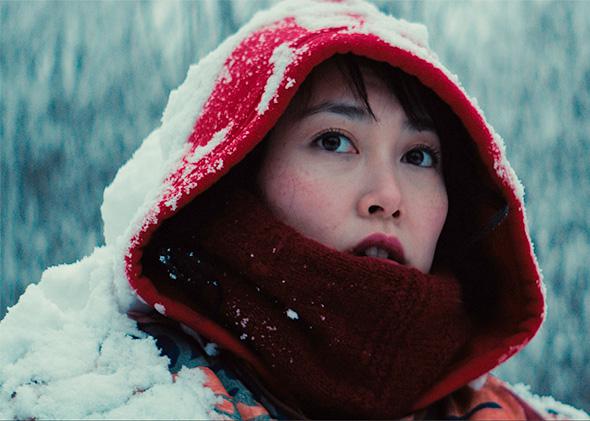“It’s just a regular normal movie,” a bewildered sheriff’s deputy tells the heroine of Kumiko, the Treasure Hunter. He’s trying to explain to Kumiko (Rinko Kikuchi) that the quest upon which she’s set herself—to find the treasure that a bloodied, battered Steve Buscemi buries in Fargo—makes no sense, because Fargo is not a documentary or a reality show. It’s not a true story. (Never mind the Coen brothers’ cheeky pre-credits title card suggesting that it is, which also makes several appearances in Kumiko.) “It’s just a regular movie,” the well-meaning deputy repeats, struggling to make himself clear.
Given that the actor playing that deputy is David Zellner, the director of Kumiko, the Treasure Hunter, the line feels a bit like a statement of purpose. Yes, Fargo is no regular normal movie to Kumiko, a depressed and lost “office lady” for a Tokyo firm who becomes obsessed with the notion that the million bucks buried in the snow by Buscemi’s character is still out there somewhere for her to discover. Fargo (and the secrets it contains) is her ticket out of a dissatisfying life and crushing sadness.
But Zellner (who, in Coens fashion, co-wrote the movie with his brother Nathan, who also produced) is also tugging at the big ideas hovering around the edges of this hypnotic modern fairy tale. Kumiko is not a regular normal movie, but it’s not quite a true story either; instead, it’s based on an urban myth about a Japanese woman, Takako Konishi, found dead in the Minnesota woods in 2001. A local policeman, confused, inferred she was looking for the treasure from Fargo; by the time her suicide note arrived at her parents’ house in Japan three weeks later, the story had swept the pre-viral internet. Out of this lonely death the Zellner brothers have crafted a film about the way images and stories can infect our imaginations, one as weird, mysterious, and ultimately unsatisfying as the tale upon which it’s based.
As Kumiko, Kikuchi (nominated for a 2006 Oscar for Babel) presents as deeply depressed, if not disturbed. Disheveled and scowling in a Tokyo workplace full of bright, chipper young “office ladies,” Kumiko has no friends other than her pet rabbit Bunzo. Her mother hectors her over the phone about her lack of a boyfriend; her boss annoys her to the point that she toys with spitting in his tea. The only thing that inflames her passions is her well-worn VHS copy of Fargo, which she watches each night in her tiny apartment, making notes and drawing maps of the location of the crucial suitcase burial. “I’m like a Spanish conquistador,” she says when asked what she’s trying to accomplish. “It’s my destiny.”
In the film’s first half, Zellner and his talented cinematographer, Sean Porter, capture Kumiko through doorways, trap her in library stacks, even shoot her walking a narrow pet store aisle gauntlet between shrieking monkeys. In Japan she’s trapped in a life that has hemmed her in; once she arrives in Minnesota (“THE NEW WORLD,” a title announces), her vistas broaden. In fact, the horizons of the Upper Midwest are almost nonexistent, the line between white sky and white snow imperceptible. A tiny, red-hooded form against this limitless void, Kumiko looks like a character from a story older than time, or a figure in a dream.
Her quest is obviously absurd, but the movie rarely treats it absurdly. In Fargo, the money sets off a chain of catastrophic comic events; in Kumiko, kind people try to help Kumiko, only to have her shake them off for reasons that are never made clear. The Zellners tell their story with straight faces, tongues well out of cheeks—I expected, at first, to hear silly Minnesota accents or that Kumiko would meet Mike Yanagita, but in the end the Zellners don’t intend Kumiko to be an homage to Fargo, as rich a source of meta and metaphor as it is.
Instead, the Zellners want to sink headfirst into a mystery, and their unwillingness to interrogate their heroine’s quest is both admirable and discomfiting. I don’t have any idea why Kumiko embraces a fiction, ignores the clear and obvious truth, and marches out into the snow in Kumiko, the Treasure Hunter, and I don’t think the Zellners do either. Instead, they seem to be telling us that we can never really understand why anyone does what they do, or dreams what they dream. I can’t say that this austere, beautiful movie satisfied my impatient desire for answers. (It seems, in fact, to be a rebuttal to that desire.) But I’ll be thinking about Kumiko’s journey for a long time.
